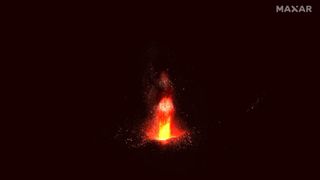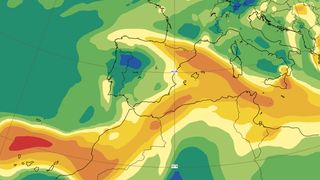La Palma volcano eruption's infernal beauty visible from space (Photos)

New astronaut and satellite images of an active volcano on the island of La Palma reveal the frightening beauty of the eruption, as well as its dangerous proximity to humans.
Lava began gushing out of the Cumbre Vieja crater on the island, which is located off the coast of northwestern Africa and governed by Spain, on Sunday (Sept. 19). On Wednesday (Sept. 22), European Space Agency astronaut Thomas Pesquet shared an image of the eruption as seen from his perch on the International Space Station.
"Set against the blackness of the surrounding Atlantic Ocean the bright orange glow is even more impressive," Pesquet wrote in a tweet.
Related: 10 incredible volcanoes in our solar system in photos



Meanwhile, satellites have also been hard at work monitoring the eruption. New high-resolution images taken by a satellite operated by Earth-observation company Maxar Technologies on Tuesday (Sept. 21) at 11:54 p.m local time (6:54 p.m. EDT or 2254 GMT), show the volcano's geyser of lava. Maxar then combined this image with that of a wider view captured during daytime. The combined image reveals a dense patchwork of buildings and roads stretching up the flank of the volcano nearly to the edge of the crater.
Scientists from all over the world continue to closely monitor the ongoing eruption, Cumbre Vieja's first since 1971, and predict the effects the rest of the world might feel from the thick plumes of smoke and ash it spews spreading through Earth's atmosphere.
Related: Satellites watch volcano erupt on La Palma after half a century of silence
According to the European Union's Copernicus Atmosphere Monitoring Service (CAMS), the sulfur dioxide-rich smoke will continue spreading northwest over Morocco, Algeria and the rest of the Mediterranean region. The plume will move over Spain and reach central France by the end of this week, CAMS previously predicted.
Sign up for the Live Science daily newsletter now
Get the world’s most fascinating discoveries delivered straight to your inbox.
CAMS Senior Scientist Mark Parringron said in a new statement that the effects of the sulfur dioxide plume on weather and air pollution levels on the ground will likely be negligible. At ground level, the gas can irritate the respiratory tract and worsen conditions such as asthma. Sulfur dioxide can also react with other compounds in the atmosphere and form aerosol particles that contribute to particulate pollution. In combination with atmospheric water, it can cause acid rain, which can damage trees and plants. However, most of the sulfur dioxide coming from Cumbre Vieja is at high enough altitudes, 3 miles (5 kilometers) up, not to carry these threats.
"Most of the emitted sulfur dioxide is much higher up in the atmosphere, especially as you get further away from the source," Parrington said. "[It] might just be visible as a light haze up in the sky."
Related: Images: 10 incredible volcanoes in our solar system

The Volcanic Ash Advisory Center in Toulouse, France, is also monitoring the La Palma eruption for the spread of volcanic ash that could jeopardize airplanes. (In 2010, a six-month eruption of the Eyjafjallajökull volcano in Iceland caused the worst air traffic disruption in Europe since World War II.) For now, the center said, the ash can only be detected in the relative vicinity of the volcano.
As Cumbre Vieja continues spewing lava and smoke, more residents are forced to leave their homes as the slow-moving but unstoppable lava river continues to spread down the volcano's western flank, bulldozing everything in its way. Geologists worry that the lava, up to 1,800 degrees Fahrenheit (1,000 degrees Celsius) hot, could trigger explosions and release toxic gases once it reaches the ocean and mixes with the sea water, which is expected to happen today (Sept. 23).
The lava flow has already buried over 350 buildings and submerged more than 0.64 square miles (166 hectares) of land, according to the European Union's Copernicus Emergency Management Service.
Scientists had expected the volcano to erupt since mid-September due to intense seismic activity. Over 22,000 mild earthquakes had shaken the island within the week prior to the eruption, alerting geologists to the magma bubbling up the volcano towards the surface.
Follow Tereza Pultarova on Twitter @TerezaPultarova. Follow us on Twitter @Spacedotcom and on Facebook.

Most Popular




